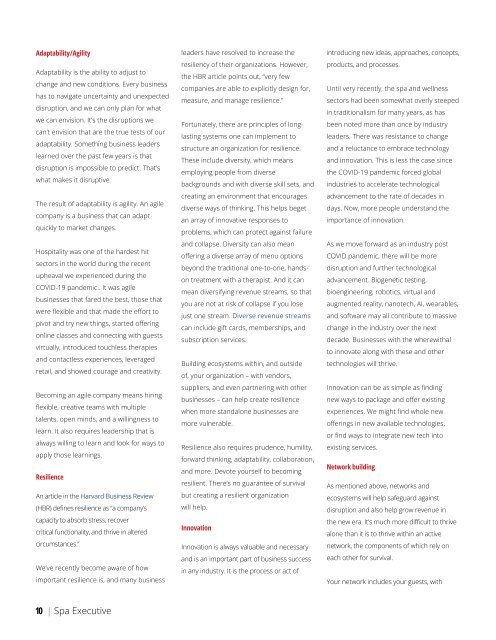Spa Executive October 2022
Spa Executive magazine, October 2022 issue
Spa Executive magazine, October 2022 issue
Create successful ePaper yourself
Turn your PDF publications into a flip-book with our unique Google optimized e-Paper software.
Adaptability/Agility<br />
Adaptability is the ability to adjust to<br />
change and new conditions. Every business<br />
has to navigate uncertainty and unexpected<br />
disruption, and we can only plan for what<br />
we can envision. It’s the disruptions we<br />
can’t envision that are the true tests of our<br />
adaptability. Something business leaders<br />
learned over the past few years is that<br />
disruption is impossible to predict. That’s<br />
what makes it disruptive.<br />
The result of adaptability is agility. An agile<br />
company is a business that can adapt<br />
quickly to market changes.<br />
Hospitality was one of the hardest hit<br />
sectors in the world during the recent<br />
upheaval we experienced during the<br />
COVID-19 pandemic.. It was agile<br />
businesses that fared the best, those that<br />
were flexible and that made the effort to<br />
pivot and try new things, started offering<br />
online classes and connecting with guests<br />
virtually, introduced touchless therapies<br />
and contactless experiences, leveraged<br />
retail, and showed courage and creativity.<br />
Becoming an agile company means hiring<br />
flexible, creative teams with multiple<br />
talents, open minds, and a willingness to<br />
learn. It also requires leadership that is<br />
always willing to learn and look for ways to<br />
apply those learnings.<br />
Resilience<br />
An article in the Harvard Business Review<br />
(HBR) defines resilience as “a company’s<br />
capacity to absorb stress, recover<br />
critical functionality, and thrive in altered<br />
circumstances.”<br />
We’ve recently become aware of how<br />
important resilience is, and many business<br />
leaders have resolved to increase the<br />
resiliency of their organizations. However,<br />
the HBR article points out, “very few<br />
companies are able to explicitly design for,<br />
measure, and manage resilience.”<br />
Fortunately, there are principles of longlasting<br />
systems one can implement to<br />
structure an organization for resilience.<br />
These include diversity, which means<br />
employing people from diverse<br />
backgrounds and with diverse skill sets, and<br />
creating an environment that encourages<br />
diverse ways of thinking. This helps beget<br />
an array of innovative responses to<br />
problems, which can protect against failure<br />
and collapse. Diversity can also mean<br />
offering a diverse array of menu options<br />
beyond the traditional one-to-one, handson<br />
treatment with a therapist. And it can<br />
mean diversifying revenue streams, so that<br />
you are not at risk of collapse if you lose<br />
just one stream. Diverse revenue streams<br />
can include gift cards, memberships, and<br />
subscription services.<br />
Building ecosystems within, and outside<br />
of, your organization – with vendors,<br />
suppliers, and even partnering with other<br />
businesses – can help create resilience<br />
when more standalone businesses are<br />
more vulnerable.<br />
Resilience also requires prudence, humility,<br />
forward thinking, adaptability, collaboration,<br />
and more. Devote yourself to becoming<br />
resilient. There’s no guarantee of survival<br />
but creating a resilient organization<br />
will help.<br />
Innovation<br />
Innovation is always valuable and necessary<br />
and is an important part of business success<br />
in any industry. It is the process or act of<br />
introducing new ideas, approaches, concepts,<br />
products, and processes.<br />
Until very recently, the spa and wellness<br />
sectors had been somewhat overly steeped<br />
in traditionalism for many years, as has<br />
been noted more than once by industry<br />
leaders. There was resistance to change<br />
and a reluctance to embrace technology<br />
and innovation. This is less the case since<br />
the COVID-19 pandemic forced global<br />
industries to accelerate technological<br />
advancement to the rate of decades in<br />
days. Now, more people understand the<br />
importance of innovation.<br />
As we move forward as an industry post<br />
COVID pandemic, there will be more<br />
disruption and further technological<br />
advancement. Biogenetic testing,<br />
bioengineering, robotics, virtual and<br />
augmented reality, nanotech, AI, wearables,<br />
and software may all contribute to massive<br />
change in the industry over the next<br />
decade. Businesses with the wherewithal<br />
to innovate along with these and other<br />
technologies will thrive.<br />
Innovation can be as simple as finding<br />
new ways to package and offer existing<br />
experiences. We might find whole new<br />
offerings in new available technologies,<br />
or find ways to integrate new tech into<br />
existing services.<br />
Network building<br />
As mentioned above, networks and<br />
ecosystems will help safeguard against<br />
disruption and also help grow revenue in<br />
the new era. It’s much more difficult to thrive<br />
alone than it is to thrive within an active<br />
network, the components of which rely on<br />
each other for survival.<br />
Your network includes your guests, with<br />
10 | <strong>Spa</strong> <strong>Executive</strong>

















